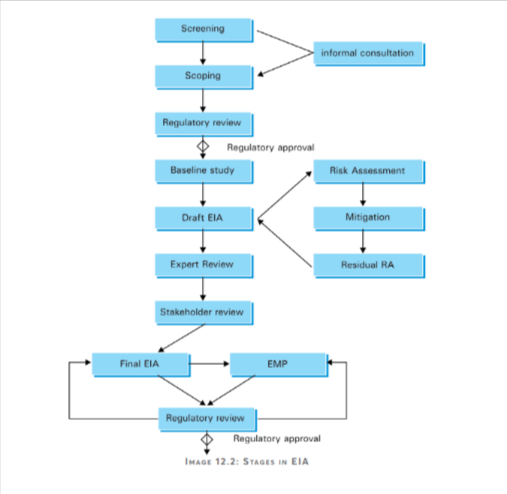Environment Impact Assessment or EIA can be defined as the study to predict the effect of a proposed activity/project on the environment. A decision making tool, EIA compares various alternatives for a project and seeks to identify the one which represents the best combination of economic and environmental costs and benefits.
History of EIA in India
a) In India, The EIA Process has been practised for over 20 years. If we look at the history of EIA in India, the EIA Process started in 1976-77, when the Planning Commission requested that the Department of Science and Technology do an environmental assessment of the river-valley projects. Until 1994, environmental clearance by the Central Government was purely an administrative decision with no legal underpinning.
b) Under the Environmental (Protection) Act 1986, the Union Ministry of Environment and Forests (MoEF) of the Government of India promulgated an EIA notification on January 27, 1994, requiring Environmental Clearance (EC) for any expansion or modernization of any activity or the establishment of new projects listed in Schedule 1 of the notification. Since then, the EIA notification of 1994 has been amended 12 times.
c) In September 2006, the Ministry of Environment and Forestry (MOEF) published revised EIA regulations. Various projects, such as mining, thermal power plants, river valleys, infrastructure (roads, highways, ports, harbours, and airports), and industries, including very tiny electroplating or foundry units, were required to obtain environmental clearance under the notification. Unlike the EIA Notification of 1994, the new legislation has placed the burden of project clearance on the state government, depending on the project’s size and capabilities.
d) Certain operations permitted under the Coastal Regulation Zone Act of 1991 also necessitate the same level of permission. Furthermore, donor organizations operating in India, such as the World Bank and the Asian Development Bank, have environmental clearance criteria for projects they sponsor.
Steps in the EIA process
The EIA process includes the procedures indicated below. On the other hand, the EIA mechanism is cyclical, with interactions between the many phases.
- Screening: The project plan is examined to determine its size, location, and construction method, as well as whether it requires legislative permission
- Scoping: The project’s possible effects, impact zones, mitigation strategies, and monitoring criteria
- The EIA agency must adhere to the Ministry of Environment, Forest, and Climate Change (MoEFCC) published guidelines
- Collection of baseline data: The study area’s environmental status is the baseline data
- Impact prediction: Reversible and irreversible, positive, negative, immediate, and permanent effects must be expected, which requires the evaluation agency to provide a thorough understanding of the project
- Mitigation measures and EIA report: The EIA report should provide actions and measures for avoiding, reducing, or mitigating the impacts, as well as the extent of compensation for potential environmental harm or failure
- Public hearing: After the EIA report is completed, the public and environmental groups residing near the project site who are Stakeholders in the EIA Process may be notified and consulted
- Making a decision: The Impact Assessment (IA) Authority, in consultation with experts, consults the project manager and a consultant to make a final decision, bearing EIA and EMP in mind (Environment Management Plan)
- Environmental management plan monitoring and implementation: The project’s various implementation phases are monitored
- Risk assessment: Inventory analysis and hazard probability and index are also included in the EIA process
Shortcomings of the EIA process
- One of the significant shortcomings of the EIA process is that Public input is not taken into account at an early stage, which often leads to controversy at a later stage of project approval
- Another significant shortcoming of the EIA process is the issue with the quality of EIA reports due to Limited technical and managerial capacities
- Inadequate alignment of EIA work at critical decision points in the project life cycle about the feasibility and associated studies, with some vital choices being made even before EIAs are finished
- Difficulties in ensuring the appropriate and helpful public engagement of the Stakeholders in the EIA Process (or participation)
- Inadequate understanding of the relative functions of baseline definition and impact prediction is another Shortcomings of the EIA process
- Inconsistency in the collection of technologies requires detailed environmental impact assessment studies
- Environmental Impact Assessment issues are exacerbated by a lack of integration of biophysical, ecological impacts with social, economic, and health repercussions
- There are no connections between the mitigation and monitoring recommendations in the environmental impact assessment report and project implementation and operation
- Lack of processes to ensure that EIA reports are included in decision-making

Shortcomings with EIA process
- Public comments are not considered at the early stage, which often leads to conflict at the later stage of project clearance
- Issues with the quality of EIA report due to Limited technical and managerial capacities
- Insufficient alignment of EIA work at key decision points in relation to feasibility and related studies in the project life cycle, with some big decisions being taken even before EIAs are completed
- Difficulties in ensuring appropriate and useful public engagement (or participation)
- Inadequate understanding of the relative functions of baseline definition and impact prediction
- Inconsistency in the collection of technologies requiring detailed environmental impact assessment studies
- Poor integration of biophysical environmental impacts with social, economic and health effects also adds to the Problems in Environmental Impact Assessment
- impact assessment report recommendations on mitigation and monitoring and project implementation and operation
- Lack of processes to ensure that EIA reports are included in decision-making
 Profile
Profile Settings
Settings Refer your friends
Refer your friends Sign out
Sign out













